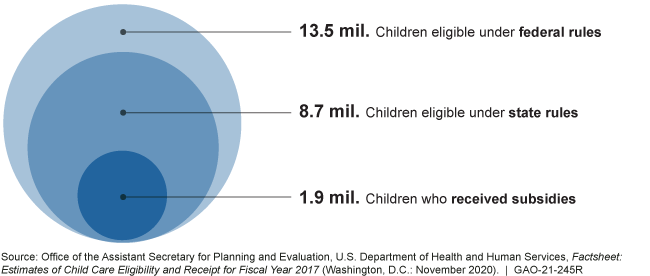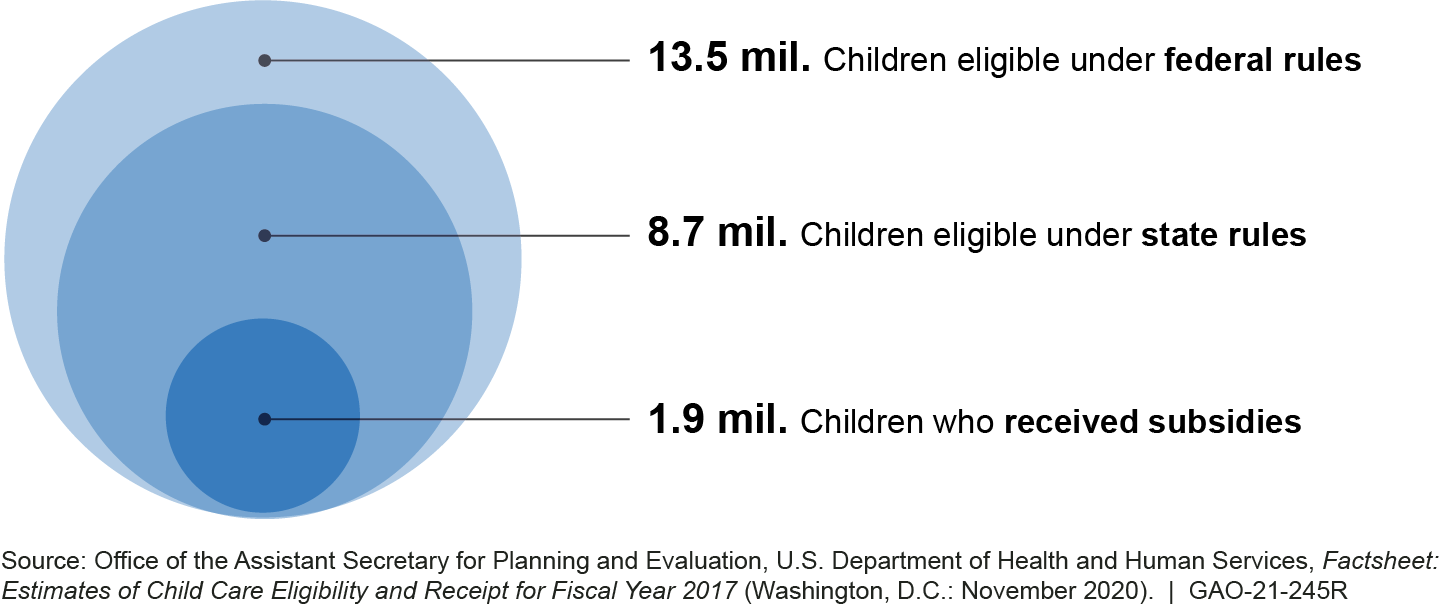Child Care: Subsidy Eligibility and Receipt, and Wait Lists
Fast Facts
A federal fund gives subsidies to low-income families to pay for child care while parents work or attend school. Here's some information we found about the fund:
According to the Department of Health and Human Services, fewer families qualify for subsidies under state rules because most states set stricter income limits than the federal max
Lower-income families with preschoolers got the most subsidies
Some states use wait lists to manage caseloads, but it's hard to maintain the lists
Some states reported higher child care costs as more families sought full-day care for older kids due to school closings and other effects of COVID-19

Highlights
What GAO Found
An estimated 1.9 million children received child care subsidies in fiscal year 2017, representing approximately 14 percent of all children estimated to be eligible under federal rules – and 22 percent of all children estimated to be eligible under state rules -- in an average month. These figures are from the Department of Health and Human Services' (HHS) analysis of fiscal year 2017 data, the most recent year for which such analysis is available. Generally, fewer families qualify for subsidies under state eligibility rules than under federal eligibility rules since most states use flexibility provided by HHS to set their income eligibility limits below the federal maximum.
Health and Human Services’ Estimated Number of Children Eligible Under Federal and State Rules, and Estimated Number Receiving Child Care Subsidies, Fiscal Year 2017

GAO found that the extent to which children who meet federal child care eligibility requirements also meet state eligibility requirements varies by state as does the share of eligible children who receive Child Care and Development Fund (CCDF) subsidies. Under state requirements, the CCDF subsidy receipt rate ranged from 5 percent to 32 percent of eligible children. Under federal requirements, the CCDF subsidy receipt rate ranged from 4 percent to 18 percent of federally eligible children.
According to HHS estimates, among families who met federal child care eligibility criteria, children from lower-income families were more likely to receive child care subsidies compared to children from higher-income families. These estimates also showed that preschool-age children were more likely to receive subsidies compared to older, school-age children and that Black children were more likely to receive subsidies compared to children of other races / ethnicities.
As reported in previous GAO work, states have varied strategies for managing their wait lists. Some states have a single statewide list while others have sub-state lists that allow sub-state areas to have their own policies. Some states conduct full or partial eligibility determinations prior to placing families on wait lists, and many states require periodic reviews of their wait lists. According to state administrators GAO interviewed, the strategies that states use to manage their wait lists pose certain challenges. For example, state administrators told GAO that sub-state lists can contain duplication, making state-wide estimates of families in need difficult. And administrators told GAO that maintaining up-to-date contact information is challenging, in part due to insufficient technology.
The Coronavirus Disease 2019 (COVID-19) pandemic has impacted child care in several ways, including cost, eligibility and subsidy receipt, according to some members of the National Association of State Child Care Administrators (NASCCA). These members told GAO that despite initial declines in the number of families receiving subsidies, some states are seeing their child care costs increase due to, for example, more school-age children using full-day care; increased expenses for additional health and safety measures; paying for more absences and for parent co-pays; and families applying for subsidies for relative care. NASCCA members noted that some states have made changes to policies to help families and providers. To help families access child care, some states have increased income eligibility for subsidies to 85 percent of the state median income; temporarily waived work requirements to receive subsidies; and covered family fees for parents when a family must quarantine due to a COVID-19 exposure. Changes to some state policies aimed at helping providers include providing funds to providers to help with increased costs, such as personal protective equipment (PPE) and additional cleaning supplies; paying providers based on their pre-COVID-19 level authorized enrollments; and raising the state's provider reimbursement rate to help providers cover overhead costs.
Why GAO Did This Study
The federal child care subsidy program known as CCDF is one of the primary sources of federal funding dedicated to assisting low-income families with child care who are working or participating in education and training. Funding for CCDF, which is administered by HHS at the federal level, comes from two funding streams: discretionary funding in the form of block grants authorized by the Child Care and Development Block Grant (CCDBG Act) of 1990, as amended, and mandatory and matching funding authorized under section 418 of the Social Security Act. CCDF was appropriated more than $8 billion in federal funds in 2019.
For more information, contact Kathryn Larin at (202) 512-7215 or larink@gao.gov.
